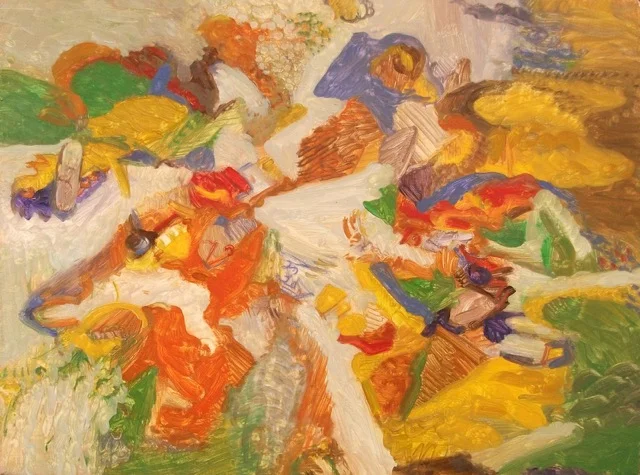Color Matters
Curated by Jack McWhorter, Al Peters, James Patrick Reid
Exhibition Dates: January 5, 2016 - January 30, 2016
Reception: Thursday, January 7, 6 - 8 pm
The Painting Center presents Color Matters, an exhibition featuring work by April Hammock, Barbara Campbell Thomas, Becky Yazdan, Carla Aurich, Claudine Metrick, Kimberly Thorpe, Fukuko Harris, Louise P. Sloane, Marianne DeAngelis, Ophir Agassi, Ruth Ava Lyons and Stephanie Franks. Together, the artworks examine how color relationships function, on many levels, with their own logic. By definition, the first, or root, level of color usage is the purely abstract manipulation of the element of color for its own sake. It can be perceptual, realistic, theoretical or symbolic.
In April Hammock’s work, images embedded within comprised layers of colors suggest moving landscapes expressing the inevitable flux of time, implying the rise and fall of things, both small and great, from the sun rising to a drop penetrating a small pond. Barbara Campbell Thomas’ paintings siphon the onslaught of words, text, images, sounds, textures and physical stuff into piecemeal orderings of stacked lines and quasi-geometric forms. These adamantly physical works are a means of building exuberant unfolding space analogous to our dense sensory existence. For Becky Yazdan, color and pattern combine to become conversations and expressions that tell a story of things seen, read, and watched on TV, as well as memories of colors, such as the pink of her favorite childhood bathing suit or the first time she told a lie. Fukuko Harris negotiates an interior dialogue with experience of the world to invoke awkward relationships intended to reflect our time. She works on the painting until all marks, lines, and forms allow themselves to unite as a singular world and start their own dialogue to create a special moment. Ophir Agassi’s paintings evolve from their original concepts, either into bigger paintings or onto another material, such as clay. He changes shapes, colors, and other elements of the paintings as the work evolves. For Carla Aurich, color is the starting point in her paintings. She explores unique color relationships that are sourced from natural and artificial worlds. The interaction and conversation between the materials and surfaces happen through the combined effort of structure and chance. Claudine Metrick’s paintings are part of a larger series titled Fisherman's Woman, which explores the separation and ensuing loneliness inherent in some marriages. These images address Metrick's own experience of individual identity in the context of marriage – an intense entanglement of two people. The resultant works are psychological landscapes filled with images of boats, fish, hearts, cages, and vessels.
Stephanie Franks’ work is a search for relationships of color and form that feel true. She may begin by exploring the space between her and that which is observed, erasing and redefining to discover the image, but as she finds her way with color, recognizable imagery can be left behind. In Ruth Ava Lyons paintings, a deep struggle is taking place that challenges our invisible connection to the world. Her paintings are evidence of a personal search to comprehend universal themes of growth, resistance, adaptation, and perseverance that she sees in nature and in her own life. Marianne DeAngelis paintings explore the complexities of color – reflections on wet pavement, worn street posters, passing scenery through the passenger window, wildflowers, walking through the forest, the golden light of sunsets, aged painted walls...decay, life and renewal – inviting an intimate dialogue and contemplation via the relationship of color. The visual language of Louise P. Sloane’s paintings embraces the legacies of reductive and minimalist ideologies, while celebrating the beauty of color and the human connection to mark-making. The way the brain registers color, movement and spatial/geometric relationships is at the heart of her work. Kimberly Thorpe’s paintings are inspired by landscape and figurative imagery and abstraction. Recalling experiences of watching moving water in very small streams, rivers, lakes and oceans that suggest swirling, surging, tumbling and imploding movements, Thorpe creates a mood or atmosphere of immersion and envelopment in a brilliant and dusky light.
View Catalogue: Color Matters_Catalogue.pdf













